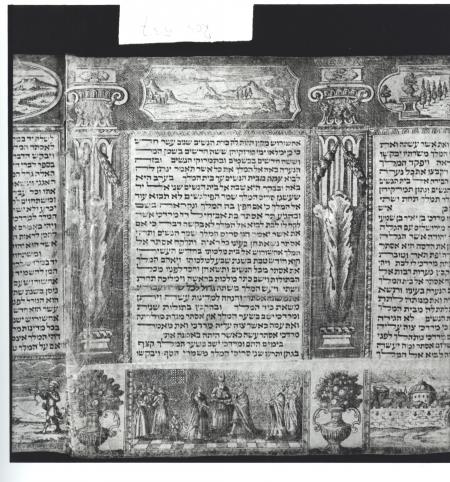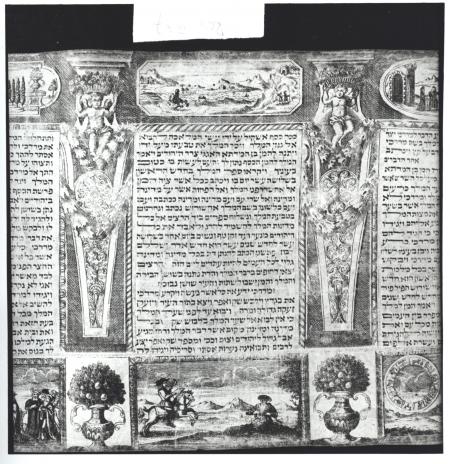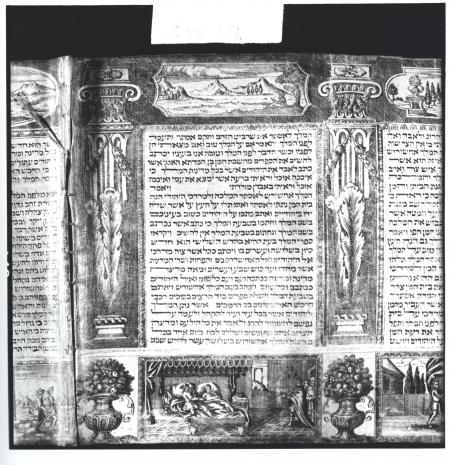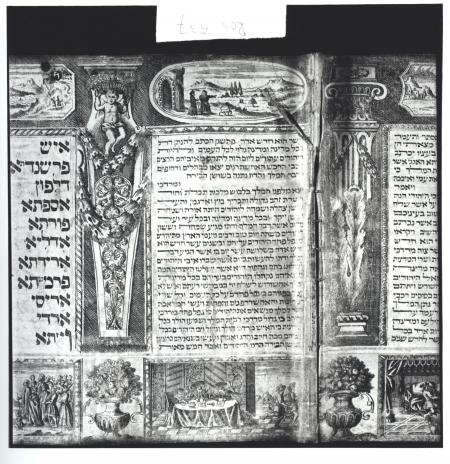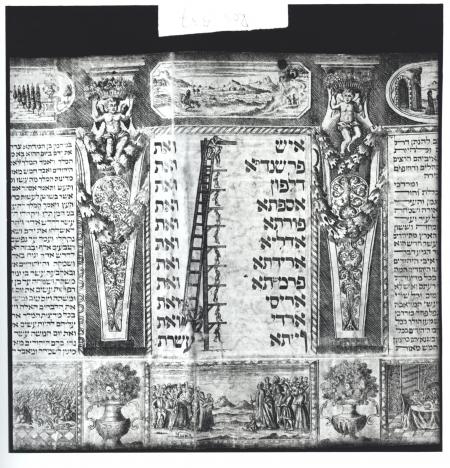Obj. ID: 23758
Hebrew Illuminated Manuscripts Esther Scroll with Landscapes I from an Unknown Collection (2)Amsterdam (?), early 18th century

The scroll represents the type called "scrolls with landscapes" because the decorative scheme of them features four different landscapes framed in cartouches that fill upper margins and repeat on every sheet in the same order:
1. On the left, two men with a dog standing at the gate are shown against a landscape of mountains and trees that are visible in the background.
2. On the right, two wanderers going towards a hill with buildings. On the left, a man on a horseback riding towards a bridge over a river. In the background, mountains, and trees are visible.
3. A garden with a fountain and a palace in the background.
4. On the right, a man sitting under a tree and, in the background, mountains, trees, and buildings are visible.
It is difficult to show a direct reference between the landscapes and the narrative of the Book of Esther, although such a connection cannot be excluded either (e.g. two men in the second landscape can be the king's messengers and a man sitting under the tree in the fourth landscape can be Mordecai).
The scrolls with landscapes are lavishly decorated megillot produced in a mixed technique in which decorative border is printed as a copper engraving (and in some exemplars, colored by hand), whereas the Hebrew text of the Book of Esther is penned by a scribe. All of them begin with a panel composed of several figurative scenes from the Book of Esther narrative. The text columns are interspaced by herms decorated with reliefs, elaborate acanthus leaves and garlands above which are either decorative capitals or putti holding baskets with flowers on their heads. Lower margins are filled with the figurative scenes that chronicle the Purim story, allude to midrashim or other sources; they are interspersed by vases with plants. This type of megillot is known in two variants marked "I" and "II" (see "Additional Remarks").
Similar narrative scenes are included in the scrolls with "portrait medallions" (see their descriptions in the Index); some of them are their mirror image.
This image belongs to the ''Ursula and Kurt Schubert Archive'' in the Center for Jewish Art.
Formerly in the collection of the Bibliotheca Rosenthaliana in Amsterdam (Ros 537). The current location of the manuscript is unknown.
There are two variants of the scrolls decorated with this pattern that in the Index are marked "I" and "II". In some exemplars, just below the decorative herms, the pedestals with angel's heads and bases were added, therefore, the text panels are higher; this type is marked with "II". Whereas, the rest of the manuscripts containing no pedestals with angel's heads and bases are marked with "I". The latter are more numerous.
The earliest scroll sharing similar engraved pattern is dated to 1701; this is the megillah BCM 25 from the Braginsky Collection in Zurich (see http://braginskycollection.com/esther-scrolls/; accessed on 22.04.2020).
L | Landscape
V | Vase
C | Columns
P | Putto (Putti in Plural)
A | Acanthus Leaf
G | Garland
B | Basket | Basket with flowers
|





